Digital Frontier
Header
Main
CG MAKING
GANTZ:O
October 2016 [CG]
Our largest amount of effects work ever,
with action from beginning to end.
The creation of “Gantz: O”, a full CG film of extraordinary scale and innovative visuals, was a unprecedented challenge for even CG specialists. We will talk with Yasushi Kawamura (Director), Keisuke Takahashi (Concept Artist), Kazutake Saito (CG Supervisor), Toshio Ishida (Technical Director) and Takahiro Matsui (Effects) who all led the film through its initial concept, development and finishing touches and through discussion find out how such unique visuals were created.
The concept art that guided the project
This is not to say that we didn’t work in this way before but for this project we made decisions in a particularly logical fashion.
Production moved pretty systematically so I don’t think there were major changes to the overall direction in the rough guide from two years prior and the final guide.
If you look at our color script you’ll notice that when we first enter Osaka, the scenes are depicted in an eerie way paralleling the character Kato’s anxiety in the moment through the use of blue-tinged fog. One big challenge we had was whether or not to continue to depict the scenes in the same way at night. So depending on the shot, we did things like change the color of lights to make them bolder or exaggerate existing elements so they looked different compared to earlier.
For instance, at Ebisu Bridge, the first scene made use of blue lighting and we used nearby yellow street lighting to change the tone suddenly if needed. There were a lot of scenes at the Ebisu Bridge scenes so used these lights to express temporal changes. At the beginning we use peaceful blues to express Kato’s anxiety. But when Nurarihyon appears midway in the scene we also wanted to make it appear as if the sense of time also changed so we eliminated some of the neon lights and dropped overall illumination in the scene. Since this was also a pretty dramatic moment, Kawamura suggested that we add more helicopter searchlights to evoke a greater sense of danger. After the 3rd stage collapse, the last boss destroys the surrounding buildings so we also used things like the flames and environmental fog produced to change the tone.
On the actual location scout, we discovered that the sky turns pitch black after the neon lights go out at 12am. It really gave the scene a terrifying tone.
I was lucky to join the background team for the Osaka location scout. I was able to adjust the actual elements to develop shots and make use of real lighting.
Using the color script in parallel I drew a more detailed color key, which provided a lighting guide for each shot. I then passed the color key to the lighting, composite and effect leads.
It was in pre-production that we solidified our vision for the project. The color script and the color key were laid aside during animation and afterwards the camera and effects team used the color script and color key to bring the true, final vision to life.
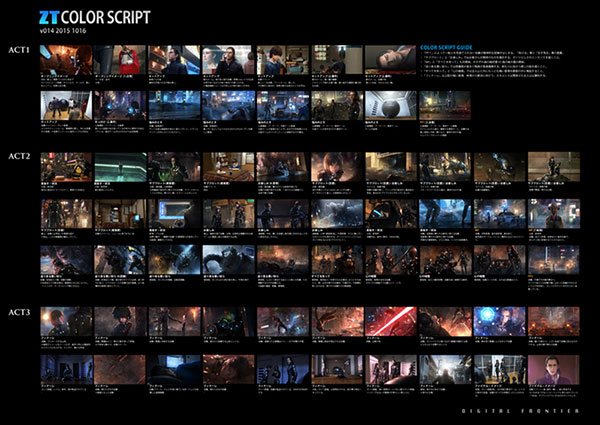 Color Script
Color Script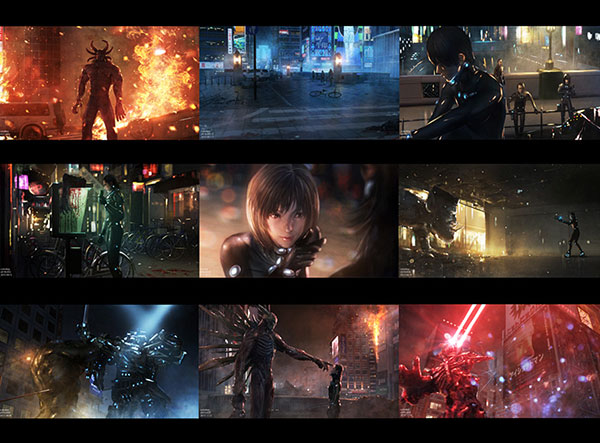 Color Key
Color Key
A combination of lighting and composites from an enormous amount of shots.
As the CG Supervisor I was given the opportunity to lead the technical aspects of composite and lighting. I use these tools like the artist’s color key to keep the artistic intention of the colors on track when the material passes through the composite stage where material has been separately lit and rendered. During lighting, the light is closer to its natural state so it’s difficult to match the way light actually hits the material versus the way it’s depicted in the color key. My job is to figure out how to manipulate the lighting base I have in front of me to express the colors we need.
With this project, we had the pleasure of having the director in-house. So the color script was finalized by the director Kawamura-san and the concept artist Takahashi-san early in advance. Most scenes were pre-visualized in such detail that we could say “let’s do this here” early in the process. I think because of this, our work later was able to thrive. In prior projects, we’d often have moments during CG production where we doubted whether what we were doing was correct.
It was probably my work that was in doubt (laugh). But you’re right. This time, we had the color script to fall back on. We approached the guidelines of this project in a more theoretical manner. I was glad that we were able to finish the project without having to rely on our gut.
During composite, we were able to adjust and tweak things like the colors of lit material without having to rely on trial-and-error as we did in past projects. It felt good to work without hesitation and know we were on the right track.
The final composited image is a little different from the pre-comp lit image but I think this is the same with live action films. After a live action shoot, through a color grade you can make a film feel like a medieval fantasy or a futuristic sci-fi film. In the same way, I’d say pre-comp lit stage in CG is similar to the original footage you get in live action shoots. Lighting has a big effect on the direction and feel of a scene so during composite you can push and alter the mood so that it’s more engaging.
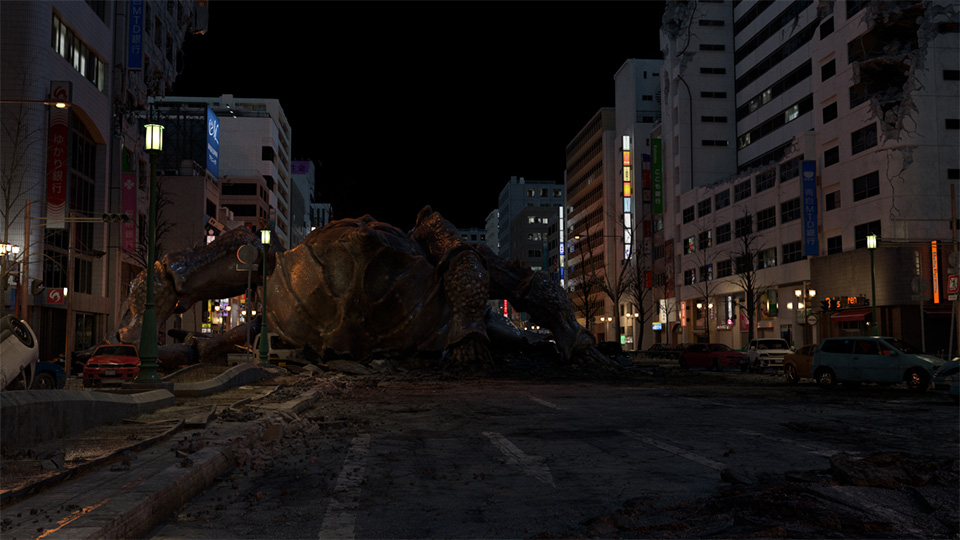 Footage of background lighting
Footage of background lighting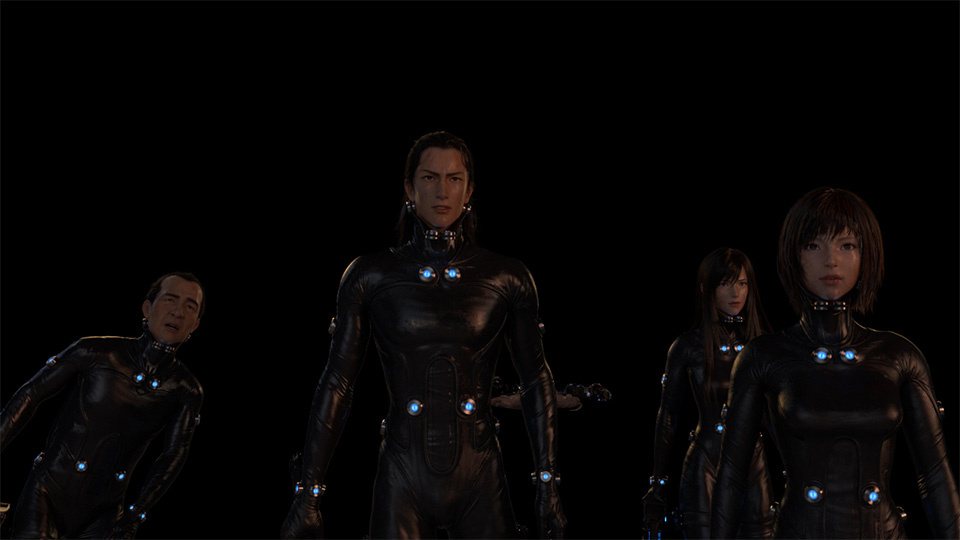 Footage of character lighting
Footage of character lighting Final composite
Final composite
With CG, we take a lit scene and use CG software to render it. And during this process we re-render each element and add things like gloss or reflection for instance. Then shot by shot we adjust the gloss a little to enhance the effect of the render.
Recently, the CG industry has started to depict worlds with a physics base, in other words trying to recreate imagery that actually occurs in the real world. But unfortunately with CG, images come out clear with no noise and you have to add “noise” to make things like cars look realistic and add color aberrations to lenses so that they look authentic to the viewer. Typically, the director will indicate that during a scene that he’d like “such and such” to happen and we on the CG side have to determine how to technically bring his vision to reality and when things are impossible we call the team together for a discussion.
-Were there times where the two of you disagreed?
Yeah! A lot of times (laugh). I had to whatever was necessary to complete the project. This meant that if I came up against something impossible and I didn’t think we had the time, I had to bring it up with the team for a discussion of alternatives.
We had a ton of material. But we leaned on the structure of the original source material to ensure the film left an impression. We struggled to balance the workload with the schedule but from the very beginning I made sure to focus first on any shots intended for the press or that would be sent out of the studio for other reasons. Within the scope of the film’s schedule, we decided that scenes like the robot vs Gyuki (the Demon-Ox) scene would impress the general audience. And I remember having to redo those scenes a lot (laugh).
I don’t really remember (laugh). That scene was the first to go out, we had a number of guidelines to follow since we couldn’t afford to drop the ball.
Yeah. I remember it being pretty difficult as a team member, rather than as the supervisor.
I also had to do practical work like compositing.
That was one of our strengths. It was great to be able to work with a director with a CG production background, someone that had done the actual work before and could take our CG workload into account so that weren’t pushed to do the impossible. If we had worked with a primarily live action director that didn’t really understand CG work we’d most likely have been put in an impossible situation - being assigned to execute unreasonable ideas that didn’t exist from the beginning but that he just wanted to try in the middle of the production.
-But isn’t it true that you can do anything you want in CG?
That’s not true (laugh)!
If you don’t consider time, then I guess it’s true. But if you want a high quality result you need a ton of time since you have to deal with a large amount of data.
In addition to our technical struggles, my job was to make it feel as if the image quality was consistent across the long duration of the film. I had to manage a large amount of designers of varying skill levels over the course of over 1400 shots.
The technical director’s job is to develop the tools necessary to allow us to give every team member a manageable workload and at the same time make sure that we never fall behind schedule.
The development of tools to keep the work smooth and consistent.
We’re supposed to make tools to help every department run efficiently but the TD team itself didn’t have enough people. I, myself, was leading a project of this size for the first time and on top of that I also took on the challenge of creating a new type of pipeline. There were a lot firsts. We began the full-blown production on April 2015. But before that we had discussions like “this would be best” and “that would be best”. It was at this point that I was placed assigned as a lead in the production so by the time we officially started production the asset work had already begun. I remember thinking that it would have been a huge risk if we messed up just one asset because it would have put every subsequent department in shambles.
-What kinds of tools did you have?
If we rely on people to pass asset work and shot work deliverables to the next stage, it becomes difficult to determine the data type, where to upload it, and where to find it. There have been times when incorrect data was uploaded so with this project we decided to depend less on the work of people and instead depend entirely tools to avoid mistakes.
When we talk about CG shot work, we’re talking about a staggering amount of data. It’s simply unrealistic to manually bring together data from over 1400 shots that include polygon model based character and background data, the cache of the results of simulations, effect data and data from manual labor.
The tools we developed work with each department (animation, facial, effects, simulation, etc) to provide data necessary for work on a given scene, letting us know how much work each department has finished, and using Shotgun to give people the information necessary to efficiently manage the project.
CG is the gathering of material that doesn’t actually exist. You can break an element down as much as you want and in the same way you build as much as you want. If done by hand, it takes an insane amount of time to gather the material necessary to bring a scene to life. But with Ishida’s programming, we can use the strength of technology to bring everything together at the touch of a button.
Because of this tool, we were also able to shorten the work time. We created the CG necessary for a film of this length in a relatively short amount of time since every single department was working in parallel. After each department finished all of its work they’d pass it to the next appropriate department without a problem. But without a tool like this, we’d most likely have created duplicate work which would have led to questions like which work was the latest and how much needed to be completed. Without the automation provided with this innovative tool, we wouldn’t have been able to tackle this film.
I thought it would have been impossible to meet the schedule if I had a discussion with every team and then afterwards made the tools. So instead I decided that I focused on developing simple and easy-to-understand tools that could adapt to a team’s specific needs.
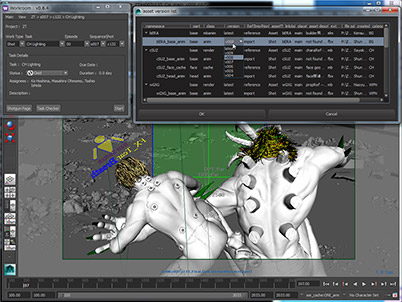 The “workRoom” tool
The “workRoom” tool
This tool allows an artist, from the minute s/he starts a project, to do things such as download the data, request necessary work tools, and publish work.
 The “workRoom Plus” tool
The “workRoom Plus” tool
A tool that automatically decides tasks. It registers multiple processes and manages each at once.
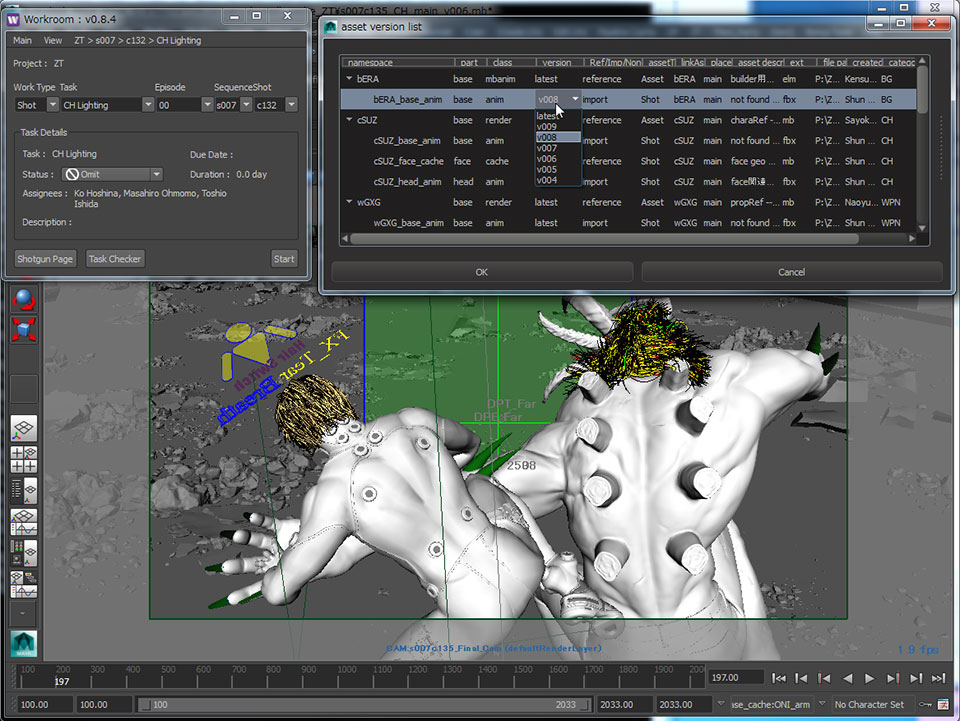 The “workRoom” tool
The “workRoom” tool
This tool allows an artist, from the minute s/he starts a project, to do things such as download the data, request necessary work tools, and publish work. The “workRoom Plus” tool
The “workRoom Plus” tool
A tool that automatically decides tasks. It registers multiple processes and manages each at once.
The largest number of effects to date
This project was full of effect-driven action scenes. It appeared that the effects team even had it the hardest.
In this company, I have the most CG film experience but this was undeniably the largest amount of effects I’d have ever encountered.
We had about 900 shots with effects in them and over 1900 types of effects to deal with.
Hmm....
No “hmmm”! They were all orders that came from you Kawamura (laugh).
Not that. I just can’t wrap my mind around numbers like that.
In the early, rough stages, we had conversations with the director about where effects should go and were also allowed to give suggestions. The director was very detailed regarding what he wanted from shot to shot in this film. And within his ideas we able to work out in fine detail how the effects should be attached.
In the last battle sequence in particular we had a ton of things happening and it was difficult to understand how we’d divide the work.
The Nurarihyon would shoot out his laser all over the place so we created an overhead map video to visualize where the laser blasts landed and what was broken.
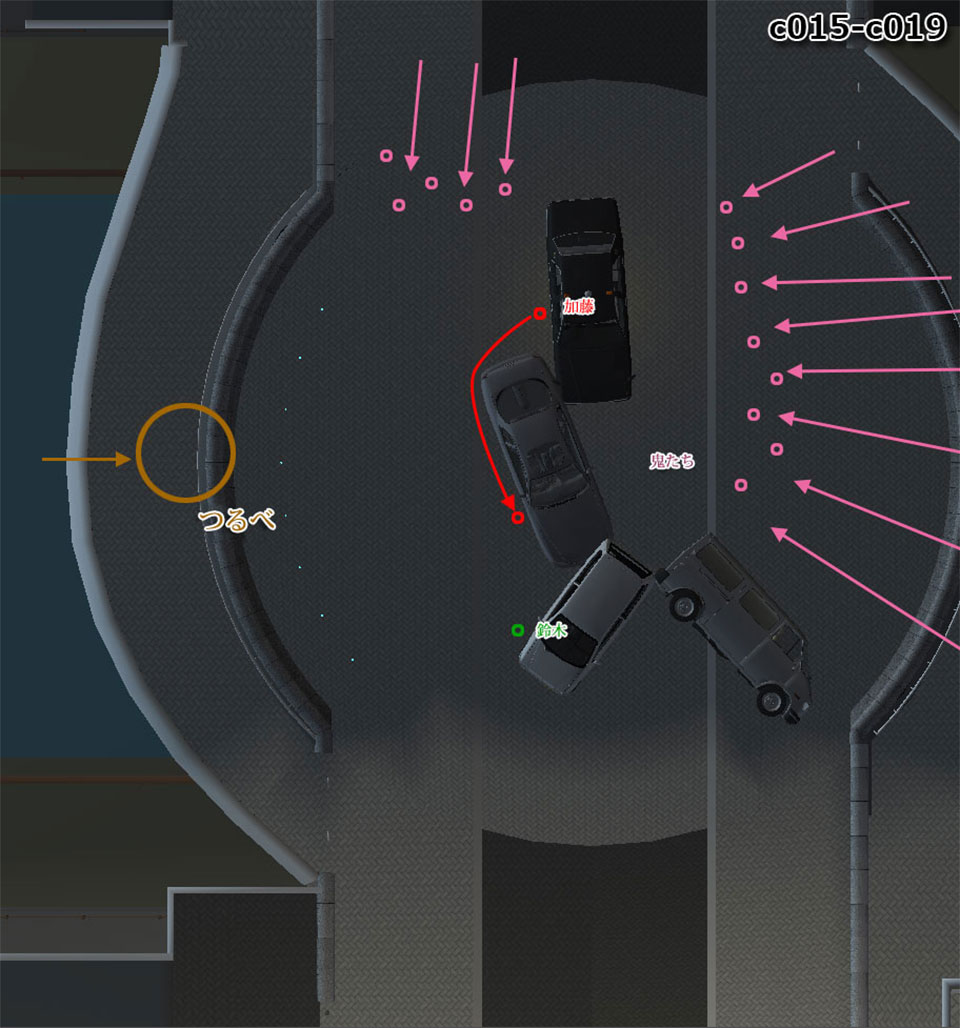 Map Video
Map Video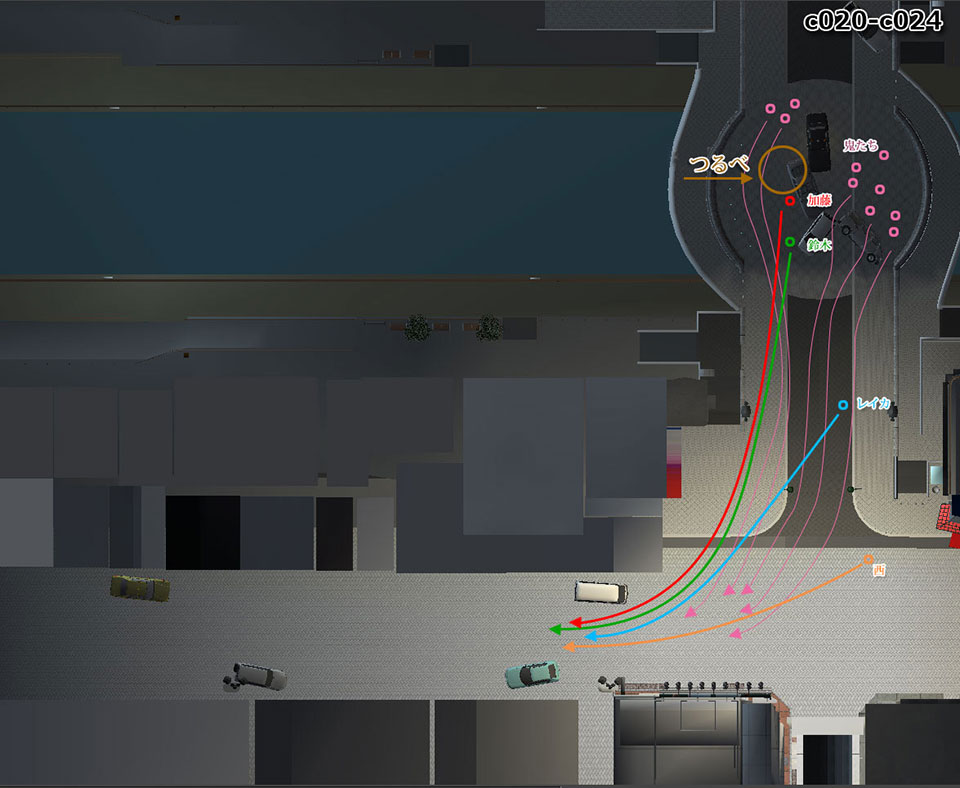
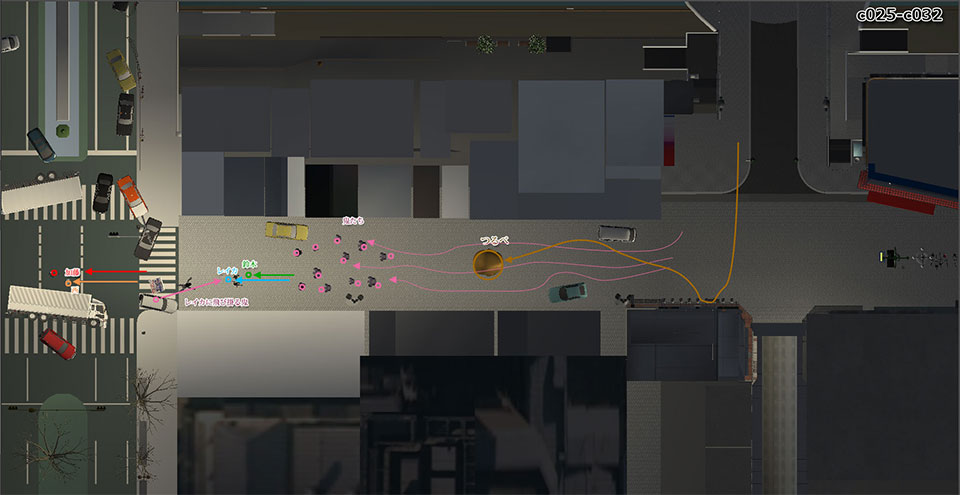
Yeah, when things like explosions occurred, the background lighting changed moment by moment.
Because of the map we were able to see how explosions outside of the frame influenced the lighting of the scene. We used this info as a base to prepare our workflow and gathered additional reference documents to match the data this map provided. This allowed each artist to determine, with precision, how and what type of effect to create. Relying on purely verbal communication would have resulted in mistakes since each person interprets feedback and direction differently.
-How did you go about creating effects like fire and smoke?
When we created physics simulations with the 3D software, we didn’t just simply start the simulation. We started first thinking about what exactly wanted to highlight in the shot and what imagery would be the most appropriate. After deciding this, we executed an appropriately tweaked simulation.
For instance, we’d first decide how many particles of smoke we needed, although you can’t really “see” a smoke particle. If we had a lot of particles, it would look realistic but at the same the data size of so many particles would be too much to deal with. So instead, we had to determine at what amount the shape would look close enough.
-What was the most difficult scene you had?
There were too many difficult scenes (laugh). Typically when we have a project we can roughly see the end in sight. But for this film, not matter how far into it we got, the ending never became clear. I personally think that the spraying of water in the shot with Gyuki took the longest amount of time. In that shot, there were millions of water particles so just one simulation took about 7 days to execute.
 The arrival of Gyuki shot.
The arrival of Gyuki shot.
The shot itself was only 15 seconds but the computer took about 7 days to do the calculations. And if it was no good, it would take another 7 days to process. So at the beginning of each test, we only used a few particles to confirm that a bigger amount would move in the right way. That was the fastest way to process the data.
During simulations we often had waiting time so we’d work on other jobs. Effect work typically repeats in this way.
Are the cache files for water really more than one TB?
Yeah really really. By the end, one shot would be about 3 terabytes.
For one of our previous films, Appleseed (2004), the total amount of data on the server was about 2 TB but I can’t believe that in this film just one water spray was about 3TB. The amount of information used in CG has increased tremendously. You often hear this but I can’t believe that 64KB file size of a picture in an email is the same file size as the entire original Dragon Quest video game.
Conceptually, making a CG movie is the process of using 3D data to bring into existence spaces and objects in a virtual world. It’s a process that is closer to live action movie than the traditional 2D anime. But unlike live action movie, in CG, the amount of data needed to capture a given scene has a huge impact on the workload. In the production of older movies shot on film, the length and size of 1 second of film stock didn’t change whether you had a pitch black scene where nothing is seen or a scene full of large scale spectacles. Today, live action movies are shot digitally so depending on what is shot, the amount of data recorded to the camera changes. But at the end of the day, a digitally recorded live action movie still gives you a 2D flat image in the same way old film-recorded movie does regardless of the angle. With a CG movie however, every element in the “world” is created and after that you decide the way in which you’d like the image to be output. Depending on this image style chosen, experienced specialists become essential in outputting the image properly. Master craftsmen like these put their passion into the creation of the captivating, new film epic “Gantz: O”.
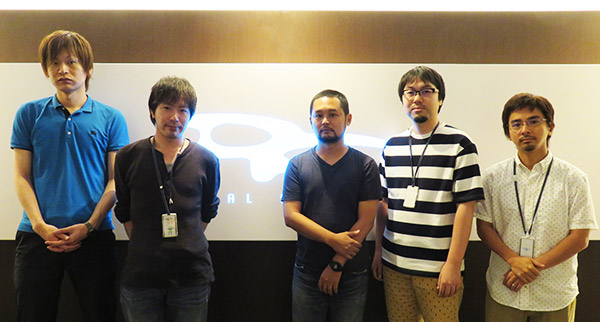 (From the left) Matsui, Saito, Kawamura, Ishida and Takahashi.
(From the left) Matsui, Saito, Kawamura, Ishida and Takahashi.
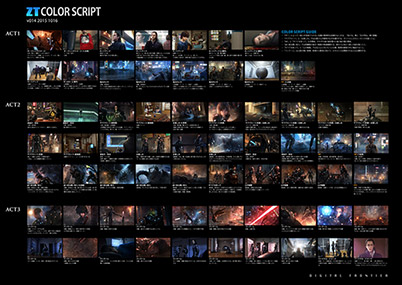
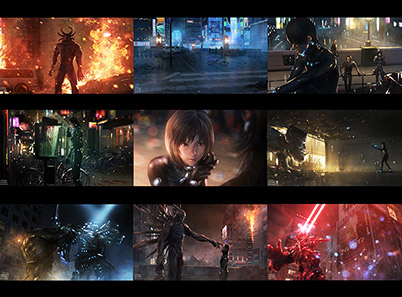
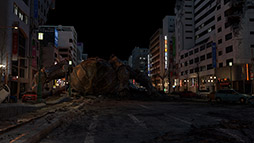
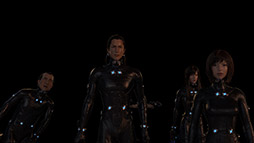

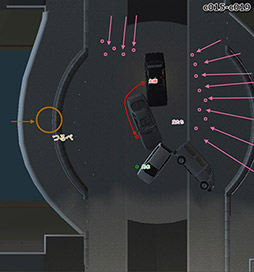

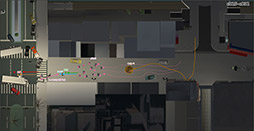
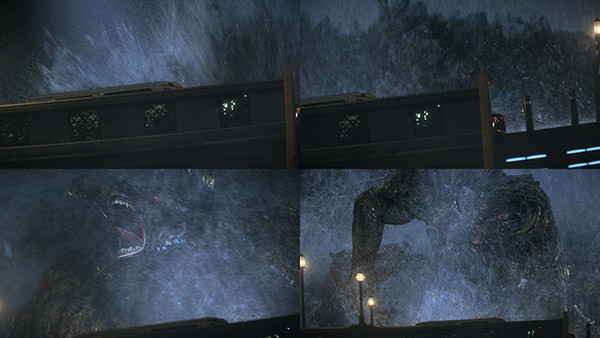
TAKA-
HASHI
As the CG Art Director for “Gantz: O” my main work was developing the artwork related to shot development from pre-production to production. This mainly meant that I dealt with the color script and the color keys.
The first thing Kawamura and I struggled with after analyzing the script was how to make visuals that matched the flow of the story. As Kawamura made comments throughout the script, I brainstormed how we would actually visualize the scenes in the script and started to develop the art in this way.
As far as the actual production process, one of the first things we decided was to create a bold opening that would grip the audience. So I created catchy imagery to match this need. The first scene of the film starts off ordinary and everyday but then in the very next scene things suddenly turn strange so in same style the visual tone completely changes from the first scene to the second to evoke a feeling of anxiety. I created art in this way to help guide these type of large story fluctuations.